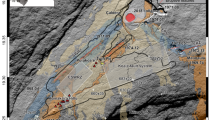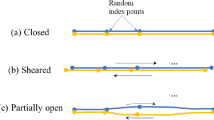Abstract
In some geomechanical treatments of induced seismicity, the fault surface is idealized to be a plane. We depart from this assumption by comparing a discretization model and a kriging model, both of which allow the incorporation of rugosity, roughness, and curvature into the fault surface and subsequent geomechanical models of hazard. We test the Hogback Flexural Faults of the San Juan Basin, which could potentially pose a problem for induced seismicity in a carbon sequestration project in the northwestern portion of the basin. The discretization model emmeshes data about the location of the fault surface in three-dimensional space into hexagonally close-packed spheres. Each sphere that contains enough data is termed a region and Bayes’ Law is used to find a distribution of strikes and dips that describe the data within the region. The kriging model uses Gaussian processes to interpolate and extrapolate a surface through all data points. The results show that the discretized regions possess, in general, lower Coulomb failure functions, but the uncertainty in the distributions, i.e., the ranges, becomes greater as the discretization increases due to overfitting. The majority of the uncertainty in both the discretization model and the kriging model is contained in the geomechanical priors. Finally, the discretization and kriging of the fault surface elucidates locations with higher Coulomb failure functions.
Similar content being viewed by others
Data availability
The datasets generated during and/or analyzed during the current study are available in the EDX repository, https://edx.netl.doe.gov/dataset/fault-discretization.
References
Ellsworth, W.L.: Injection-induced earthquakes. Science 341(6142), 1225942 (2013)
Segall, P., Grasso, J.R., Mossop, A.: Poroelastic stressing and induced seismicity near the Lacq gas field, southwestern France. J. Geophys. Res.: Solid Earth 99(B8), 15423–15438 (1994)
Bommer, J.J., Crowley, H., Pinho, R.: A risk-mitigation approach to the management of induced seismicity. J. Seismolog. 19(2), 623–646 (2015)
Eaton, D.W., Igonin, N.: What controls the maximum magnitude of injection-induced earthquakes? Lead. Edge 37(2), 135–140 (2018)
Field, E.H., Jordan, T.H., Jones, L.M., Michael, A.J., Blanpied, M.L.: The potential uses of operational earthquake forecasting. Seismol. Res. Lett. 87(2A), 313–322 (2016)
Schultz, R., Beroza, G., Ellsworth, W., Baker, J.: Risk-informed recommendations for managing hydraulic fracturing–induced seismicity via traffic light protocols. Bull. Seismol. Soc. Am. 110(5), 2411–2422 (2020)
Shapiro, S.A.: Fluid-induced seismicity. Cambridge University Press (2015)
Vilarrasa, V., Carrera, J.: Geologic carbon storage is unlikely to trigger large earthquakes and reactivate faults through which CO2 could leak. Proc. Natl. Acad. Sci. 112(19), 5938–5943 (2015)
Zoback, M.D., Gorelick, S.M.: Earthquake triggering and large-scale geologic storage of carbon dioxide. Proc. Natl. Acad. Sci. 109(26), 10164–10168 (2012)
Zoback, M., Smit, D.: Meeting the challenges of large-scale carbon storage and hydrogen production. Proc. Natl. Acad. Sci. 120(11), e2202397120 (2023)
Ampomah, W., Wang, S., & El-Kaseeh, G.: Overview of Safe Subsurface Storage of CO2 in Saline Reservoirs: San Juan Basin CarbonSAFE Phase III. Available at SSRN 4285750 (2022)
Das, S., Aki, K.: Fault plane with barriers: A versatile earthquake model. J. Geophys. Res. 82(36), 5658–5670 (1977)
Dvory, N. Z., & Zoback, M. D.: Assessing Fault Slip Potential in A Continuously Varying Stress Field–Application in the Delaware Basin. In 55th US Rock Mechanics/Geomechanics Symposium. OnePetro (2021)
Gephart, J.W.: Stress and the direction of slip on fault planes. Tectonics 9(4), 845–858 (1990)
Walsh, F.R., III., Zoback, M.D.: Probabilistic assessment of potential fault slip related to injection-induced earthquakes: Application to north-central Oklahoma, USA. Geology 44(12), 991–994 (2016)
Hennings, P.H., Snee, J.E.L., Osmond, J.L., DeShon, H.R., Dommisse, R., Horne, E., Zoback, M.D.: Injection-Induced Seismicity and Fault-Slip Potential in the Fort Worth Basin, TexasInjection-Induced Seismicity and Fault-Slip Potential in the Fort Worth Basin, Texas. Bull. Seismol. Soc. Am. 109(5), 1615–1634 (2019)
Candela, T., Renard, F., Bouchon, M., Brouste, A., Marsan, D., Schmittbuhl, J., & Voisin, C.: Characterization of fault roughness at various scales: Implications of three-dimensional high resolution topography measurements. In Mechanics, structure and evolution of fault zones (pp. 1817–1851). Birkhäuser Basel. (2009)
Morris, A.P., Hennings, P.H., Horne, E.A., Smye, K.M.: Stability of basement-rooted faults in the Delaware Basin of Texas and New Mexico, USA. J. Struct. Geol. 149, 104360 (2021)
Shelton, J.W.: Listric normal faults: an illustrated summary. AAPG Bull. 68(7), 801–815 (1984)
Vendeville, B.: Mechanisms generating normal fault curvature: a review illustrated by physical models. Geol. Soc., London, Special Publications 56(1), 241–249 (1991)
von Huene, R., Miller, J.J., Krabbenhoeft, A.: The Alaska convergent margin backstop splay fault zone, a potential large tsunami generator between the frontal prism and continental framework. Geochem., Geophys., Geosyst. 22(1), e2019GC008901 (2021)
Zoback, M.D.: Reservoir geomechanics. Cambridge University Press (2007)
Li, T., Chen, J., Thompson Jobe, J.A., Burbank, D.W.: Active flexural-slip faulting: Controls exerted by stratigraphy, geometry, and fold kinematics. J. Geophys. Res.: Solid Earth 122(10), 8538–8565 (2017)
McCormack, K.L., Bratton, T.R., Chen, T., McPherson, B.J.: Induced seismicity potential based on probabilistic geomechanics for the San Juan Basin CarbonSAFE project. Geophysics 87(6), EN69–EN79 (2022)
Krige, D.G.: A statistical approach to some basic mine valuation problems on the Witwatersrand. J. South Afr. Inst. Min. Metall. 52(6), 119–139 (1951)
Hill, R.: Elastic properties of reinforced solids: some theoretical principles. J. Mech. Phys. Solids 11(5), 357–372 (1963)
Acknowledgements
The authors would like to acknowledge support from the US Department of Energy award DE-FE-0032064.
Author information
Authors and Affiliations
Corresponding author
Ethics declarations
Competing interests
The authors acknowledge that there are no competing interests associated with this manuscript.
Additional information
Publisher's Note
Springer Nature remains neutral with regard to jurisdictional claims in published maps and institutional affiliations.
Rights and permissions
Springer Nature or its licensor (e.g. a society or other partner) holds exclusive rights to this article under a publishing agreement with the author(s) or other rightsholder(s); author self-archiving of the accepted manuscript version of this article is solely governed by the terms of such publishing agreement and applicable law.
About this article
Cite this article
McCormack, K.L., Smith, P.J. Improved spatial understanding of induced seismicity hazard from the discretization of a curved fault surface. Comput Geosci (2024). https://doi.org/10.1007/s10596-024-10276-z
Received:
Accepted:
Published:
DOI: https://doi.org/10.1007/s10596-024-10276-z




